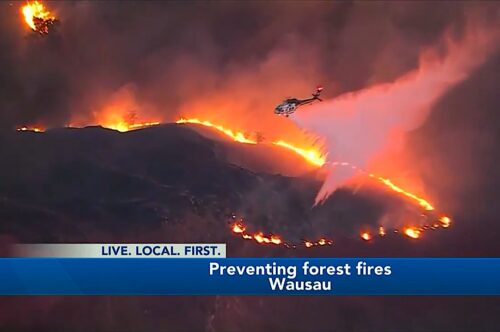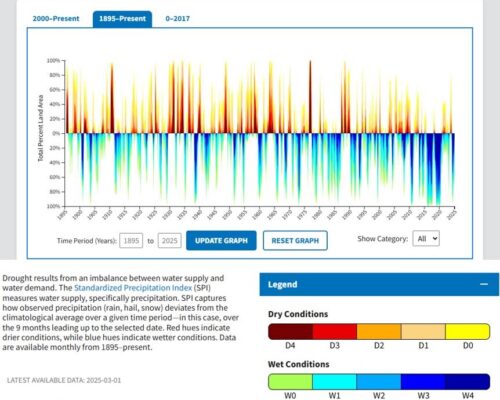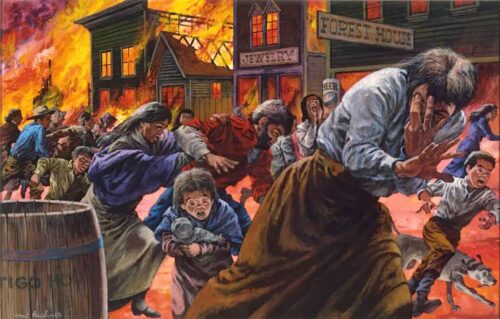

Wisconsin Public Radio (WPR) broadcast a story accusing the state of abnormal numbers in climate change in January and February. This is wrong. The early start of wildfire season cannot be attributed to climate change. [emphasis, links added]
Only the long-term trend of increasing or increasingly early wildfires can indicate that climate change is a factor in the fires this year, but there is no such trend.
Due to improved rainfall conditions over the past few years, accumulation of vegetation, population expansion into urban/forest interfaces, and human fires caused by carelessness and arson, this is the reason for the abnormal number of wildfires starting in the year in 2025.
WPR's story is “Wisconsin believes climate change drives more fire season starts to start, a long time speculation, but short in hard data and evidence,” says:
“Wisconsin had record fires in January and February this year, as climate change laid the foundation for more wildfires,” said Danielle Kaeding, an environmental and energy journalist in northern Wisconsin, WPR. According to the state Department of Natural Resources, Wisconsin has an average of 864 wildfires burning about 1,800 acres each year.
“As of Monday, there have been more than 470 fires in the state, twice the average at this time of year. 1,900 acres of land have been set.”
Kaeding interviews with Jim Bernier, manager of the Wisconsin Department of Natural Resources (WDNR) forest fire department He blamed it on two years of drought due to climate change.
“In these drought conditions we’ve experienced, we’re seeing more and more demand for these burns throughout the year,” Bernier said. “In Wisconsin, we never had so many big fires in January and February.”
Bernier's claim masks that Wisconsin is not in a drought, especially an unusually severe drought.
Data from the U.S. National Integrated Drought Information System (NIDIS) show that from January to March 2025 Precipitation is several inches higher than normal, 2025 is the 35th year [since] 1895. Currently, Wisconsin counties are not designated under drought disaster conditions.
Long-term drought data in Wisconsin show that drought conditions have not been as common as historically in the past 30 years, and the past decade has been generally particularly humid. (See the NIDIS figure below.)


The National Oceanic and Atmospheric Administration's Wisconsin state climate summary confirmed that Wisconsin has not suffered abnormal drought or extremely high temperatures in recent years, the fact reported Over the past century, the number of very hot days in Wisconsin has dropped dramatically, while precipitation in winter and summer has increased slightly or remained the same.
Wisconsin is no stranger to wildfires. Throughout history, most of its land has been forested. But wildfires were larger in the past.
As detailed by the Wisconsin Historical Society and WDNR, The largest wildfire in Wisconsin history was the Peshtigo fire in October 1871, which occurred more than 150 years before global warming.
The fire destroyed more than 1.2 million acres of land, and was actually the deadliest wildfire in American history, claiming more than 1,200 lives.


Wildfires are common throughout the state’s history, with the worst fire seasons and the vast majority of fires occurring for decades, and even over a century ago, the global average temperature was slightly lower than the current average.
If neither extreme heat caused by climate change nor the early start of the 2025 fire season, what other causes may be discovered? The January and February fires in Wisconsin may be responsible for several factors, some of which are briefly mentioned by WPR's story, at least one completely ignored.
One of the contributors to the early wildfire outbreak in Wisconsin was demographics and human ignition.
“People who burned the debris caused almost half of all fires this year,” Kanin said.[DNR] Board Chairman Bill Smith stressed that forest areas are growing in the face of the influx of retirees or people working remotely.
“The interface between wild land and urban areas accounts for about 10% of states in the state where there is a potential risk of wildfires,” said Kaeding.
“University of Western Australia-Madison researchers found that the number of homes where vegetation and home encounters has increased by 33.6% since 1990, reaching nearly 586,000 homes in Wisconsin.”
More and more people move to areas historically prone to wildfires, negligent burning garbage or leaves, embers escape from outdoor grills and wood fires, sparks on equipment, discarded cigarette butts, and even arson, causing more fires.
We have some fire source, we have fuel as well. Although Wisconsin DNR has done a lot in recent years to remove timber from forests from its management, in 2020 it released a full report, Need a sparse backlog of 16,000 acres of forest.
…More and more fires, bigger fires or fires are getting earlier and earlier, without a long-term trend.
Additionally, as Wisconsin has exceeded average precipitation in recent years, plant growth, trees and brushes are lush.
When these plants dry throughout the summer, it creates more fuel for wildfires in the forest, and if there are no cut brushes and trees in the urban/rural interface, it will be cut and managed within the expanding urban area.
With more fuel and more ignition sources, the wildfire season is coming early in Wisconsin in 2025, which is no surprise.
But the important thing to remember is that more and more fires, bigger fires or fires are getting earlier and earlier, and there is no long-term trend. As a result, wildfire outbreaks earlier this year cannot reasonably blame climate change.
Wisconsin has good data on precipitation, wildfire history and trends, and population changes. Kaeding and WPR cause damage by running another message in a long list of fake climate disaster fairy tales that detriment their audience to themselves and present it.
Top image via WSAW News Channel/YouTube Screenshot
Read more in Climate Realism
